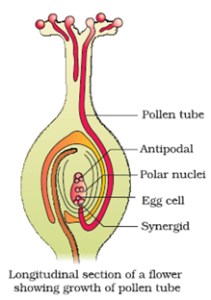Science > Biology > Botany > Reproduction in Plants > Fertilization
In last article, we have studied about pollination and its types. In this article, we shall study the process of fertilization.
Out Breeding Devices:
Most angiosperms produce bisexual flowers (hermaphrodite). But most of them avoid self-pollination naturally or we can say that in plants cross-pollination is preferred to self-pollination. Flowering plants have developed many devices to discourage self-pollination and to encourage cross-pollination.
- In some species, pollen release and stigma receptivity are not synchronized. Either the pollen is released before the stigma becomes receptive or stigma becomes receptive much before the release of pollen. It prevents autogamy.
- In some other species, the anther and stigma are placed at different positions so that the pollen cannot come in contact with the stigma of the same flower. It prevents autogamy.
- The third device to prevent inbreeding is self-incompatibility. This is a genetic mechanism and prevents self-pollen (from the same flower or other flowers of the same plant) from fertilising the ovules by inhibiting pollen germination or pollen tube growth in the pistil.
- Another device to prevent self-pollination is the production of unisexual flowers. If both male and female flowers are present on the same plant such as castor and maize (monoecious), it prevents autogamy but not geitonogamy. In several species such as papaya, male and female flowers are present on different plants, that is each plant is either male or female (dioecy). This condition prevents both autogamy and geitonogamy.
Pollen-Pistil Interaction:
All the events from the deposition of pollen grains on stigma to the entry of the pollen tube in the ovule are referred as pollen-pistil interaction. Pollination does not guarantee the transfer of the right type of pollen (compatible pollen of the same species as the stigma). Often, pollen of the wrong type, either from other species or from the same plant (if it is self-incompatible), also land on the stigma. The pistil has the ability to recognize the pollen, whether it is of the right type (compatible) or of the wrong type (incompatible).
If the pollen is of the wrong type, the pistil rejects the pollen by preventing pollen germination on the stigma or the pollen tube growth in the style. The ability of pistil to identify pollen is due to chemical stimuli.
If it is of the right type, the pistil accepts the pollen and promotes post-pollination events that lead to fertilization. Following compatible pollination, the pollen grain germinates on the stigma to produce a pollen tube through one of the germ pores. The contents of the pollen grain move into the pollen tube. The pollen tube grows through the tissues of the stigma and style and reaches the ovary.

Double Fertilization:
The process of fusion of male gamete with the female gamete to form a diploid zygote (2n) is called fertilization. The fusion of one male gamete with the egg and another male gamete with the secondary nucleus is called double fertilization. Double fertilization is a characteristic property of angiosperms. It was discovered by S. G. Navaschin in Lillium and Fritillaria species.
Pollen tube, after reaching the ovary, enters the ovule through the micropyle and then enters one of the synergids through the filiform apparatus. The filiform apparatus present at the micropylar part of the synergids guides the entry of pollen tube.
After entering one of the synergids, the pollen tube releases the two male gametes into the cytoplasm of the synergid. One of the male gametes moves towards the egg cell and fuses with its nucleus thus completing the syngamy. This results in the formation of a diploid cell, the zygote.

The other male gamete moves towards the two polar nuclei located in the central cell and fuses with them to produce a triploid primary endosperm nucleus (PEN) As this involves the fusion of three haploid nuclei it is termed triple fusion.
Since two types of fusions, syngamy and triple fusion take place in an embryo sac the phenomenon is termed double fertilization, an event unique to flowering plants. The central cell after triple fusion becomes the primary endosperm cell (PEC) and develops into the endosperm while the zygote develops into an embryo.

Significance of Double Fertilization:
- Double fertilization involves the use of both the male gametes produced by a pollen grain.
- Thus the possibility of poly-embryology and there is increases in the chances of survival of the new plant.
- There are two fusions and hence have two products.
- In the product of first fusion, the diploidy in the life cycle is restored. The diploid zygote develops into an embryo which consequently develops into a new plant.
- The second fertilization product triploid primary endosperm nucleus (PEN) develops into nutritive tissue called endosperm, which provides nourishment to developing embryo.
- Double fertilization is a characteristic feature of angiosperms, hence seeds of angiosperms are more viable.
Post-Fertilization Changes:
Development of endosperm
Endosperm development precedes embryo development. The primary endosperm cell divides repeatedly and forms a triploid endosperm tissue. The cells of this tissue are filled with reserve food materials and are used for the nutrition of the developing embryo.
In the most common type of endosperm development, the PEN undergoes successive nuclear divisions to give rise to free nuclei. This stage of endosperm development is called free-nuclear endosperm. Subsequently, cell wall formation occurs and the endosperm becomes cellular. The number of free nuclei formed before cellularization varies greatly. The coconut water from tender coconut that you are familiar with, is nothing but free-nuclear endosperm (made up of thousands of nuclei) and the surrounding white kernel is the cellular endosperm.
Endosperm may either be completely consumed by the developing embryo (e.g., pea, groundnut, beans, grams) before seed maturation. Such seeds are called non-endospermic or ex-albuminous seeds.
The endosperm may persist in the mature seed (e.g. castor, sunflower, maize, wheat, and coconut) and be used up during seed germination. Such seeds are called endospermic or albuminous seeds.

